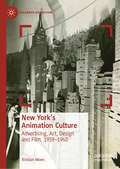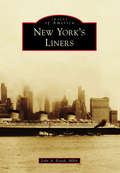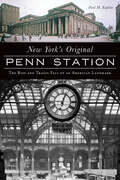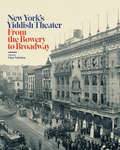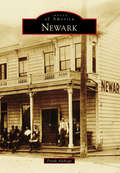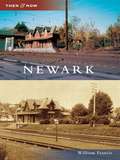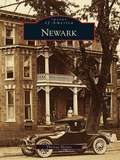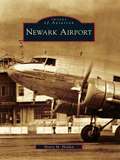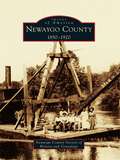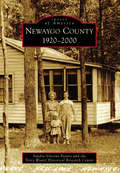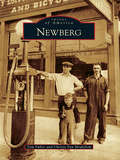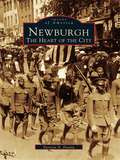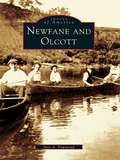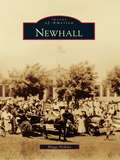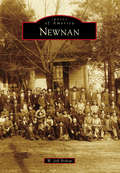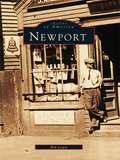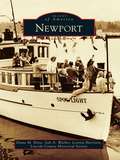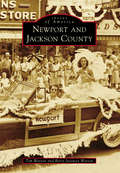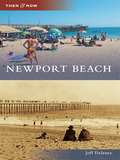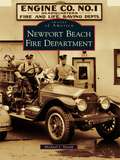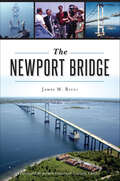- Table View
- List View
New York's Animation Culture: Advertising, Art, Design and Film, 1939–1940 (Palgrave Animation)
by Kristian MoenThis book reveals and explores the thriving animation culture in midtown Manhattan, the World’s Fair, art galleries and cinemas during a vibrant period of artistic, commercial and industrial activity in New York City. Alongside a detailed investigation of animated film at the time – ranging from the abstract works of Mary Ellen Bute and Norman McLaren to the exhibition practices of the Disney Studios and the New York World’s Fair – New York’s Animation Culture examines a host of other animated forms, including moving dioramas, illuminated billboards, industrial displays, gallery exhibitions, mobile murals, and shop windows. In this innovative microhistory of animation, Moen combines the study of art, culture, design and film to offer a fine-grained account of an especially lively animation culture that was seen as creating new media, expanding the cinema experience, giving expression to utopian dreams of modernity, and presenting dynamic visions of a kinetic future.
New York's Golden Age of Bridges
by Antonio Masi Joan Marans DimIn New York’s Golden Age of Bridges, artist Antonio Masi teams up with writer and New York City historianJoan Marans Dim to offer a multidimensional exploration of New York City’s nine major bridges, their artistic andcultural underpinnings, and their impact worldwide.The tale of New York City’s bridges begins in 1883, when the Brooklyn Bridge rose majestically over the East River, signaling the start of America’s “Golden Age” of bridge building. The Williamsburg followed in 1903, the Queensboro (renamed the Ed Koch Queensboro Bridge) and the Manhattan in 1909, the George Washington in 1931, the Triborough (renamed the Robert F. Kennedy Bridge) in 1936, the Bronx-Whitestone in 1939, the Throgs Neck in 1961, and the Verrazano-Narrows in 1964. Each of these classic bridges has its own story, and the book’s paintings show the majesty and artistry, while the essays fill in the fascinating details ofits social, cultural, economic, political, and environmental history.America’s great bridges, built almost entirely by immigrant engineers, architects, and laborers, have come to symbolize not only labor and ingenuity but also bravery and sacrifice. The building of each bridge took a human toll. The Brooklyn Bridge’s designer and chief engineer, John A. Roebling, himself died in the service of bridge building. But beyond those stories is another narrative—one that encompasses the dreams and ambitions of a city, and eventually a nation. At this moment in Asia and Europe many modern, largescale, long-span suspension bridges are being built. They are the progeny of New York City’s Golden Age bridges. This book comes along at the perfect moment to place these great public projects into their historical and artistic contexts and to inform and delight artists, engineers, historians, architects, and city planners. In addition to the historical and artistic perspectives, New York’s Golden Age of Bridges explores the inestimable connections that bridges foster, and reveals the extraordinary impact of the nine Golden Age bridges on the city, the nation, and the world.
New York's Liners
by John A. FostikFor 175 years, passenger ships have crossed the Atlantic, linking the Old World with the New World. Between 1892 and 1954, more than 12 million immigrants passed through the port of New York. National rivalries caused ships to grow in size, speed, and a comfort that had once been unimaginable. The advent of the passenger jet in 1958 changed how people travel. New York's harbor is now quieter, and there are no longer days with six liners ready to sail to fabled European ports. Happily, one can still sail to Europe, cruise the Caribbean, or take a world cruise from Manhattan aboard a new generation of liners like the Queen Mary 2. New York's Liners captures iconic images of the great ships from the 1890s to the present day.
New York's Original Penn Station: The Rise and Tragic Fall of an American Landmark (Landmarks)
by Paul M KaplanThe story of the spectacular and much-lamented train terminal whose destruction inspired a new passion for historic preservation. Includes photos. In early twentieth-century New York, few could have imagined a train terminal as grand as Pennsylvania Station. Yet, executives at the Pennsylvania Railroad secretly bought up land in Manhattan's infamous Tenderloin District to build one of the world's most spectacular monuments. Sandhogs would battle the fiercest of nature to build tunnels linking Manhattan to New Jersey and Long Island. For decades, Penn Station was a center of elegance and pride. But the ensuing rise of the airplane and automobile began to diminish train travel. Consequently, in the mid-1960s, the station was tragically destroyed. The loss inspired the birth of preservation laws in the city and the nation that would save other landmarks—such as New York&’s Grand Central, just blocks away. Here, Paul Kaplan recounts the trials and triumphs of New York's Penn Station, with extensive photos and illustrations.
New York’s Yiddish Theater: From the Bowery to Broadway
by Edna NahshonIn the early decades of the twentieth century, a vibrant theatrical culture took shape on New York City's Lower East Side. Original dramas, comedies, musicals, and vaudeville, along with sophisticated productions of Shakespeare, Ibsen, and Chekhov, were innovatively staged for crowds that rivaled the audiences on Broadway. Though these productions were in Yiddish and catered to Eastern European, Jewish audiences (the largest immigrant group in the city at the time), their artistic innovations, energetic style, and engagement with politics and the world around them came to influence all facets of the American stage. Vividly illustrated and with essays from leading historians and critics, this book recounts the heyday of "Yiddish Broadway" and its vital contribution to American Jewish life and crossover to the broader American culture. These performances grappled with Jewish nationalism, labor relations, women's rights, religious observance, acculturation, and assimilation. They reflected a range of genres, from tear-jerkers to experimental theater. The artists who came of age in this world include Stella Adler, Eddie Cantor, Jerry Lewis, Sophie Tucker, Mel Brooks, and Joan Rivers. The story of New York's Yiddish theater is a tale of creativity and legacy and of immigrants who, in the process of becoming Americans, had an enormous impact on the country's cultural and artistic development.
Newark
by Frank AddiegoOften overlooked as a minor enclave surrounded by the sprawling suburb of Fremont and confused with its New Jersey namesake, Newark, California, has been a hub of innovation commercially, industrially, and technologically, even before it officially became a city in 1955. While Newark had already been home to factories and chemical plants, citizens were reticent to allow the small town to become an industrial section of the city and thus opted out of an ambitious plan among several hamlets to become Fremont. Since then, it has become a functioning city unto its own with its own infrastructure and a passionate constituency whose spirit has made Newark a friendly city but never a boring one.
Newark
by William FrancisNew Ark, as it is pronounced and appeared on colonial maps, is located in New Castle County near the borders of Pennsylvania and Maryland. Scotch-Irish and Welsh settlers developed Newark as a market town around the intersection of two Lenni Lenape trails. Newark remained little more than a village throughout its history, reaching a population of only 11,000 by 1960. Today it is over 30,000, with an additional 15,000 students at the University of Delaware.
Newark
by Theresa HesseyDuring the past 250 years, Newark has transformedfrom a tiny farming community into a thriving small city. Its history includes the arrival of a variety of industries--including paper, woolen, and fibre mills and an automobile manufacturing plant--that have expanded the city's commercial and economic opportunities. Newark has also been home to the University of Delaware from its beginnings as a small academy in 1767. As a result, Newark's history is interwoven with that of the university. Althoughmany of the industries that once thrived in Newark have closed because of technological advances and shifting economies, the city continues to grow. Main Street is now the retail hub of the city, and stores reside in what were private residences. Despite all of the changes brought on by industry and the passage of time, Newark has maintained its small-town feel.
Newark Airport (Images of Aviation)
by Henry M. HoldenNewark Airport was the first major airport in the New York metropolitan area. It opened on October 1, 1928, occupying an area of filled-in marshland. In 1935, Amelia Earhart dedicated the Newark Airport Administration Building, which was North America's first commercial airline terminal. Newark was the busiest airport in the world until LaGuardia Airport, in New York, opened in 1939. During World War II, Newark was closed to passenger traffic and controlled by the United States Army Air Force for logistics operations. The Port Authority of New York took over the airport in 1948 and made major investments in airport infrastructure. It expanded, opened new runways and hangars, and improved the airport's terminal layout. The art deco administration building served as the main terminal until the opening of the North Terminal in 1953. The administration building was added to the National Register of Historic Places in 1979.
Newaygo County: 1850-1920
by Newaygo County Society of History and GenealogyPioneers in Newaygo County were motivated by the call of adventure and a chance to make a fortune in the vast wilderness. The first settlers came to lumber the virgin white pine that grew in the Newaygo forests. The Muskegon River flowed through the region and, along with the White River and many creeks and lakes, offered a major waterway to float logs to Lake Michigan. As early as 1837, Newaygo loggers were floating logs to market, becoming large contributors to the lumbering industry. Lumber from Newaygo County was used to rebuild Chicago after the Great Fire of 1871. In 1851, legislature gave Newaygo independence to form a county and Newaygo County entered a growth spurt that continues to this day. With the coming of the railroad in 1872 and a rapid increase in population, small settlements started popping up. As areas became logged out, many of these settlements died and have been long forgotten; many others remained and thrive today. Newaygo County: 1850-1920 preserves the history of these settlements and the people who built them.
Newaygo County: 1920-2000 (Images of America)
by Sandra Vincent Peavey Terry Wantz Historical Research CenterPeople moved into Newaygo County to farm, as the terrain offered beneficial conditions for planting crops and orchards, and eventually the area developed into several interwoven farming communities. Once agriculture took root, others businesses and crafts found a marketplace within county limits, and Newaygo began to grow while still maintaining a sense of hometown warmness and caring. Residents are proud of their heritage and history and know how to enjoy the surrounding natural beauty regardless of the season.
Newberg
by Christy Van Heukelem Tom FullerThe land that became the city of Newberg played a crucial role in the founding of the state of Oregon. It provided the second permanent encampment after Fort Astoria for trappers coming to the Pacific Northwest. Ewing Young came to Oregon in 1834, claiming as his own a vast stretch of land around his home in the Chehalem Valley. When Ewing died without a will, nearby residents gathered to settle Ewing's estate. This event led directly to the vote at Champoeg to make Oregon part of the United States. The town's name was given by pioneer Sebastian Brutscher after his Bavarian hometown of Neuburg. Other settlers arrived, and soon Newberg was a thriving pioneer town. Among the new settlers were members of the Friends Church, who set up an academy that is today one of the premier Christian universities in the country. Newberg was also home or way station to two U.S. presidents.
Newborn & Maternity Photography: Learn the Skills and Build a Business
by Kristina MackHave you always dreamt of turning your photography hobby into a business, but don't feel you have the skills or accumen to succeed? Newborn and maternity photography is one of the fastest-growing businesses for photographers to move into, and with a seasoned pro as your guide you can quickly learn the secrets of success. In this book, acclaimed newborn and maternity photographer Kristina Mack shares her knowledge of the creative and practical aspects of the genre, and also the tricky business of making a living from capturing this unique stage of the human experience.
Newborn & Maternity Photography: Learn the Skills and Build a Business
by Kristina MackHave you always dreamt of turning your photography hobby into a business, but don't feel you have the skills or accumen to succeed? Newborn and maternity photography is one of the fastest-growing businesses for photographers to move into, and with a seasoned pro as your guide you can quickly learn the secrets of success. In this book, acclaimed newborn and maternity photographer Kristina Mack shares her knowledge of the creative and practical aspects of the genre, and also the tricky business of making a living from capturing this unique stage of the human experience.
Newborn Puppies
by Traer ScottDog lovers who haven't raised puppies from birth have missed out on one of the most remarkable and adorable times in a dog's life. From one to twenty-one days old, puppies undergo great changes, from needing their mothers' complete care to opening their eyes and ears to the outside world, growing, stretching their legs, and learning to become the dogs that they are. Author/photographer (and new mother) Traer Scott's love of dogs shines through these intimate images of a range of breeds and types, from champion pups to shelter strays, all of them irresistible. Including an introduction on puppies' development and the importance of their welfare, this delightful book reveals young dogs as they embark on the adventures of growing up.
Newburgh: The Heart of the City
by Patricia A. FavataNewburgh: The Heart of the City focuses on one of the widest thoroughfares in the Northeast, Broadway, the main street in Newburgh, measuring one hundred thirty-two feet across. Known as "the heart of the city," Broadway was the activity center in the twentieth century. It was lined with government offices, commercial and business enterprises, schools, churches, restaurants, firehouses, farms, fortune-tellers, and entertainment and recreational establishments. Broadway was not only the street of everyman but also the street of presidents, playing host to both Franklin D. Roosevelt and John F. Kennedy.
Newfane and Olcott
by Avis A. TownsendNewfane and Olcott are adjoining communities in western New York where residents relish the past and look toward a prosperous future. Some say they can hear the music of the big bands playing along the shoreline of Lake Ontario from the foundation of the long-demolished Olcott Beach Hotel. Others swear they can see the ghost of Malinda standing by the upstairs window of the beautiful Van Horn Mansion, guarding the grounds where her body was lost for one hundred fifty years.
Newhall
by Maggi PerkinsNewhall's many firsts include the first gold discovery in California and the first commercially successful oil well, which led to the first pipeline and oil refinery in California. Some of the earliest movie location filming was done here. First recorded by Juan Crespi on the Sacred Expedition of 1769, the Little Santa Clara Valley was recognized by the Spanish as an important junction between the mountain ranges separating Northern and Southern California. The early city fathers of Los Angeles saw the settlement of Newhall as an integral part of their strategy for growth from the days of the stagecoach and railroad through to the building of Ridge Route and Interstate 5. This book tells the story of the town that never quite lived up to its potential but still managed a varied history with a colorful cast rivaling those of the movies filmed here.
Newnan (Images of America)
by W. Jeff BishopNewnan, founded in 1828 in the rolling Piedmont section of west Georgia, has long been known as the "City of Homes." While many small towns in the South have been burned, bulldozed, or transformed by industry and development, Newnan retains much of its 19th-century charm and elegance, including more than a dozen restored antebellum homes and a 1904 courthouse on the downtown square. The town produced two of Georgia's most progressive governors and provided writer Erskine Caldwell with his earliest, formative memories. Newnan is the small town that country music singer (and native son) Alan Jackson immortalized in his hit song "Little Man"; in these pages, readers will see the "old Lee King's apothecary" and other downtown buildings that Jackson found so inspiring during his childhood.
Newport (Images of America)
by Rob LewisFounded in 1639, the city of Newport offered a temperate climate and a wealth of natural resources to early settlers seeking religious freedom. In Colonial times, Newport flourished as one of New England's largest seaports, a prosperity dimmed only by the Revolutionary War and subsequent three-year British occupation. Despite the fact that more than one-third of existing homes in Newport were destroyed by the British during their stay, Newport today still has the largest number of eighteenth-century homes of all cities in the United States. In 1968, the Newport RestorationFoundation was founded by tobacco heiress Doris Duke to preserve, protect, and restore the city's eighteenth and nineteenth-century architecture. The foundation's extensive photographic archives have been made available to area resident and modern-day photographer Rob Lewis in the creation of this new and exciting photographic history.
Newport
by Lincoln County Historical Society Jodi Weeber Diane Disse Loretta HarrisonNewport and its surrounding areas are beautiful and bountiful, offering resources for fishing, logging, shipping, and tourism. Today's community, similar to populations that settled the land in earlier days, is independent, hearty, and versatile. The Yacona, the Native Americans who called Newport home before the arrival of other cultures, lived almost entirely off the land and waterways. Later settlers, while still reliant on natural resources, integrated technology into the growth of their society. As the area matured, the desire to find balance and preserve natural resources grew. Today Newport's heritage remains strong, and this book serves as a tribute to its history.
Newport and Jackson County (Images of America)
by Tim Watson Betsy Jacoway WatsonFor almost 200 years, Jackson County has been a typical farming community in the Mississippi Delta. Based on timber, cotton, and freshwater pearls, its early economy produced great wealth for a small group of landowners. In the 1920s, Jackson County was the 10th-largest cotton producer in the country. However, with the arrival of the tractor in the 1950s and the departure of the laboring classes, the county's economy spiraled downward. The tensions in this social mix led to a creative fermentation that allowed Jackson County to become one of the birthplaces of rock and roll. Images of America: Newport and Jackson County tells many of the colorful stories of the history of the county, from land barons and sharecroppers to Elvis, illuminating the rich heritage of its apparently simple towns and communities.
Newport Beach
by Jeff DelaneyNewport Beach, with its picturesque harbor and 10 miles of sandy beaches, has seen great change since its beginnings in the post-Civil War era. Originally a shipping port, it evolved into a haven for movie stars, rumrunners, and gamblers and finally transformed into today's exclusive beach community and popular vacation destination. In his third book on Newport Beach, author and longtime resident Jeff Delaney opens a door between Newport's past and what remains.
Newport Beach Fire Department (Images of America)
by Michael J. NovakFor nearly a century, the men and women of the Newport Beach Fire Department have served their Orange County community with dedication, professionalism, and grace. Starting with a primitive hose reel and a dozen volunteers in 1911, determined Newport Beach firefighters protected the always tourism-friendly community with more dedication than equipment. In 1927, the volunteers were disbanded and a paid fire department was organized. This volume celebrates 100 years of the Newport Beach Fire Department's exemplary service by combining historical photographs with a narrative that traces the evolution of firefighting in Newport Beach from its turn-of-the-century roots to the state-of-the-art operation it is today, entrusted with protecting one of coastal California's most affluent and picturesque showcase communities.
The Newport Bridge (Landmarks)
by James M. RicciNewport is a premier destination, but getting to the city has not always been easy.For three centuries, ferries crossed Narragansett Bay's East Passage. That all changed on June 28, 1969, the day the Newport Bridge opened, and it closed the last remaining gap between Aquidneck and Conanicut Islands. Proponents of the bridge persevered political squabbles and delays for twenty-five years following World War II to make it a reality. The longest suspension bridge in the region incorporated several new technologies and construction techniques and changed the face of Rhode Island. Author James Ricci details the trials and tribulations that produced an iconic bridge.
